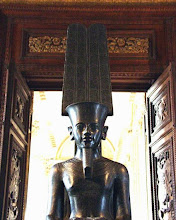The Face That Launched an International Incident
 Ok, one more time as a recap of events. For the record: In her own time she was already a trouble maker. She reminds me of Hillary Clinton actually! Look at the picture! Could be! Hahaha!
Ok, one more time as a recap of events. For the record: In her own time she was already a trouble maker. She reminds me of Hillary Clinton actually! Look at the picture! Could be! Hahaha!
Queen Nefertiti's bust has been the jewel of Berlin's Egyptian Museum since 1913. It is also one of the iconic artifacts Egyptian authorities would like to borrow for the 2011 opening of their new museum now under construction near Giza. But when they recently asked to have the 3,300-year-old artifact for a three-month loan, German authorities turned them down cold.
The Egyptian response was immediate—and outraged. "We will make the lives of these museums miserable," threatened Zahi Hawass, director of the Supreme Council for Antiquities. "It will be a scientific war."
The Germans say a loan is out of the question. According to Egyptian Museum curator Dietrich Wildung, recent tests show the bust, once thought to be painted limestone, is actually a limestone core covered with a thin layer of plaster. "It's much too delicate for [the] journey," he says.
"With all the technology and means of transportation available now, the queen can travel anywhere in the world," says Egyptian Ambassador to Berlin Mohamed al-Orabi. "Nefertiti has spent 95 years [in Berlin], and we expect some appreciation. It's unacceptable to receive this denial."
If a compromise can not be found soon, German Egyptology might suffer—and a scientific war is something scholars in both countries can ill afford.
Editor's Note: In 2003, the 3,300-year-old bust was set atop a modern bronze body and videotaped for the Venice Biennale art show. In the face of Egyptian criticism then, both that the bust was too fragile for such actions and that the bronze body was inappropriate, Wildung defended the hybrid ancient-modern artwork as "a homage to Nefertiti by means of contemporary art."






